- Home
- Get Rid Of Ants
- Flying Ants Vs Termites
Flying Ants vs Termites
This post may contain affiliate links so I earn a commission.
Infestations of flying ants vs termites can be difficult to identify because the two species look and act very similarly but pose entirely different risks to your home.
Both are winged insects that usually infest soft, water damaged wood.
Have you seen some kind of flying insect swarming around the foundation of your home, around your windows, or anywhere else in your home?
If so, you may be dealing with termites or flying ants.
It’s important to know the difference between flying ants and termites because one can cause serious damage if not taken care of immediately.
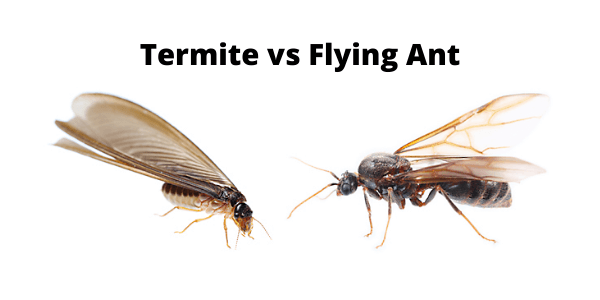
To know how to best address the issue, you need to identify which one has made itself comfortable in your house.
Once you do that, you will be able to properly take back control of your home.
Similarities Between Flying Ants vs Termites
At first glance, you may not be able to recognize the difference between flying ants vs termites.
Both are small insects with antennae, six legs, and two sets of wings.
They are relatively the same size and behave similarly, living and mating in swarms and losing their wings after mating.
Flying ants and termites will often be attracted to the same environment: soft, water damaged wood.
This kind of wood is easy to make a home in for these pests.
Many people see flying insects around their home and automatically think they are termites, as most ant species cannot fly.
Termites are a serious issue for homeowners because they can cause tremendous damage to the structure of your home.
However, if you have ants, you can relax a little.
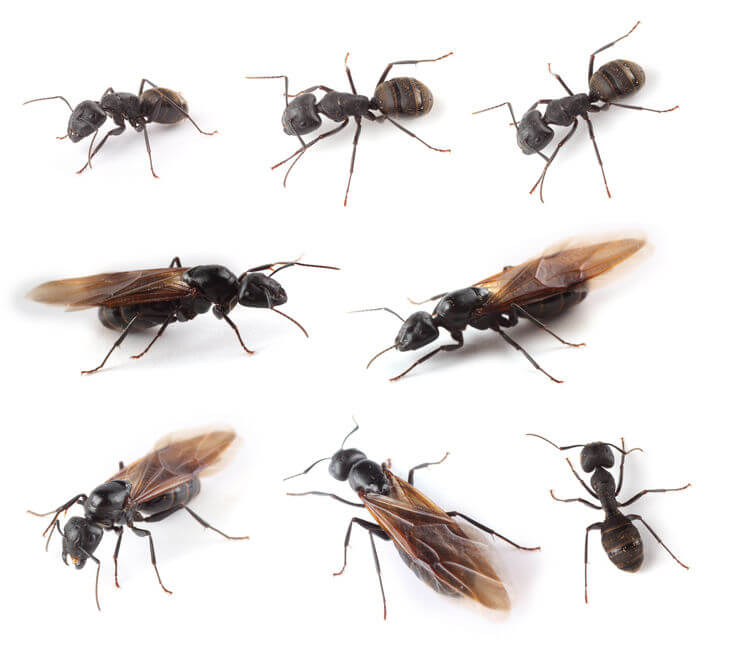 Ants With Wings
Ants With WingsIt’s still important to get flying ants out of your home, but the damage a flying ant can do is negligible compared to that of a termite or carpenter ant.
If you can look at an insect and identify flying ants vs termites, you will save yourself a lot of anxiety about knowing what exactly is infesting your home.
How To Tell Them Apart
While they are similar, there are several ways to tell the difference between flying ants vs termites.
First, you will want to get a good look at the insect you’re dealing with.
If you can capture one of them under a clear glass, you will be able to examine it closely.
Take note of the insect’s wings, antennae, and waist.
Flying ants will have bent antennae, a slim waist separating the thorax from the abdomen, and front wings that are significantly larger than the back wings.
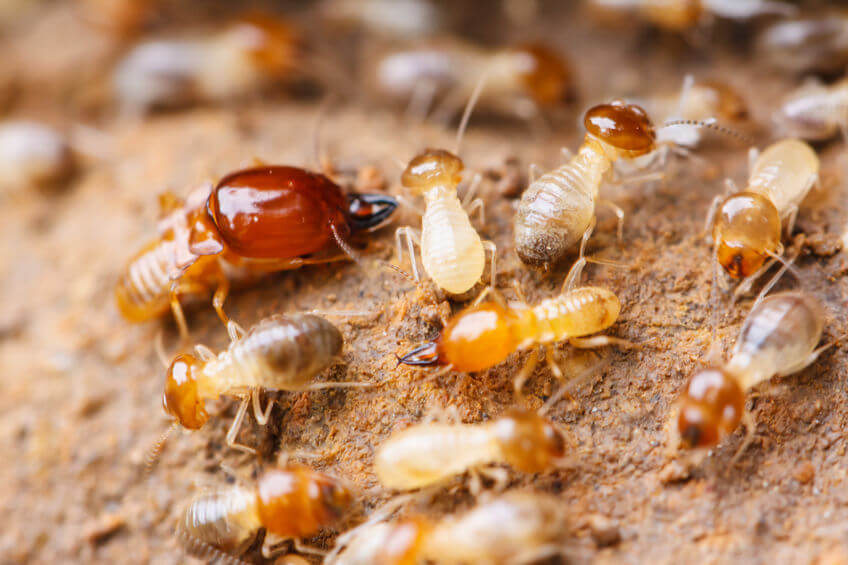 Termites
TermitesThe wings of flying ants will be relatively transparent, and you will only be able to see a few veins in the wings.
As you’re looking at the two pests, try to see what the wings look like when the insect closes them.
Termite wings will come together and create a single straight line going backward.
Flying ants, on the other hand, will have wings that remain at a slight angle to its sides, even when the ant has them tucked away.
Alternatively, termites have antennas that are straight with a small dot or bead at the end.
The body of a termite is cylindrical; there is no clear separation between the thorax and abdomen.
A termite’s front and back wings are equal in size, are milky-colored, and have more apparent veins than in flying ant wings.
You can inspect the wood around where the insects are swarming to determine what you’re dealing with.
If the wood isn’t moist, you probably have termites.
The reason for this is that flying ants will only build their homes in soft, water-damaged wood.
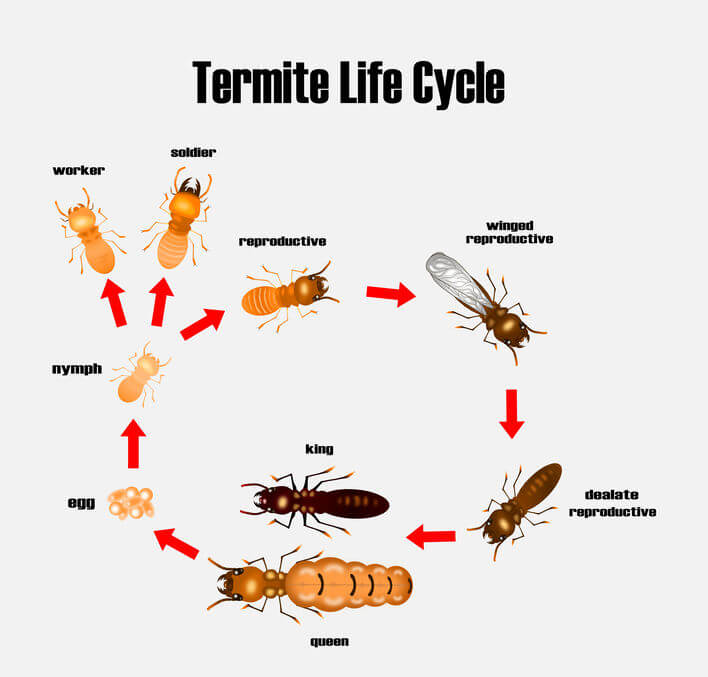
Termites also infest soft wood, but they aren’t as picky.
They are fine with eating and residing in perfectly good, undamaged, dry wood as well.
If you aren’t able to determine which bug you have based on the moisture in the wood, look at any marks left by the swarm.
Flying ants don’t eat the wood, but they will chew through it to make tunnels for their colony to reside.
Since they don’t consume the wood material, they will leave sawdust under the damaged wood.
If you see that the wood is getting darker or blistering in some places, it’s probably a case of termites.
You can also look for tunnels leading to the infested wood from outside soil.
These are signs that the little pests are termites rather than flying ants.
Risks Of Infestations - Flying Ants vs Termites
The primary concern for homeowners with an infestation is damage to your home.
Flying ants can indeed chew through the wooden structure of your home, but the damage they cause is nothing compared to that of a termite colony.
Flying ants are annoying, for sure, but a termite infestation is much more serious and should be dealt with as soon as possible.
If left long enough, termites can cause serious damage that requires expensive repairs.
If the damage isn’t repaired, it is a safety hazard.
Catching a termite infestation is key to saving yourself from the headache of having to deal with these issues.
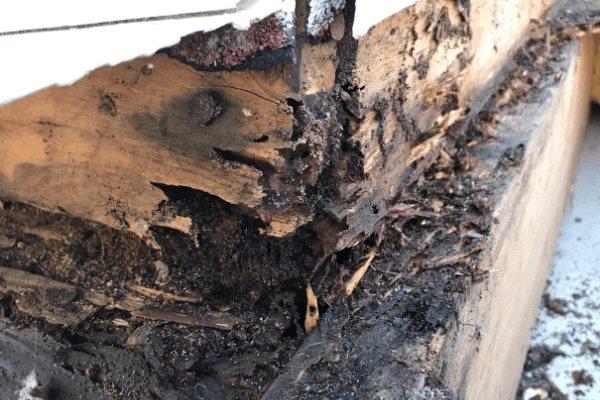 Termite Damage
Termite DamageThere isn’t a huge need to worry about ants or termites attacking you or your family.
They are only driven by mating and, in the case of termites, eating the wood in your walls.
Certain species of flying ants can bite or sting if it feels threatened, though.
Dealing With Flying Ants vs Termites In Your Home
To prevent flying ants and termites from entering your home, be sure to repair any leaks in a timely manner.
Moist wood is a structural risk on its own, without ants or termites.
When the infestation comes, your problems become much bigger than they need to be.
Replace rotted wood if you find any in or around your home.
If you’re searching for a new home, be sure to have an inspection done before you buy to be sure there is no damage from termites or flying ants.
There are different ways of handling flying ants vs. termites. If you have termites, you should hire a professional immediately.
The damage risk that comes with termites necessitates professional intervention.
If you don’t completely eradicate the termite colony, it can continue to damage your home until it is a much more expensive issue.
There are home remedies that can drive flying ant species away, but it is often wise to get the experts to help with these, as well to completely remove the pests from your home.



